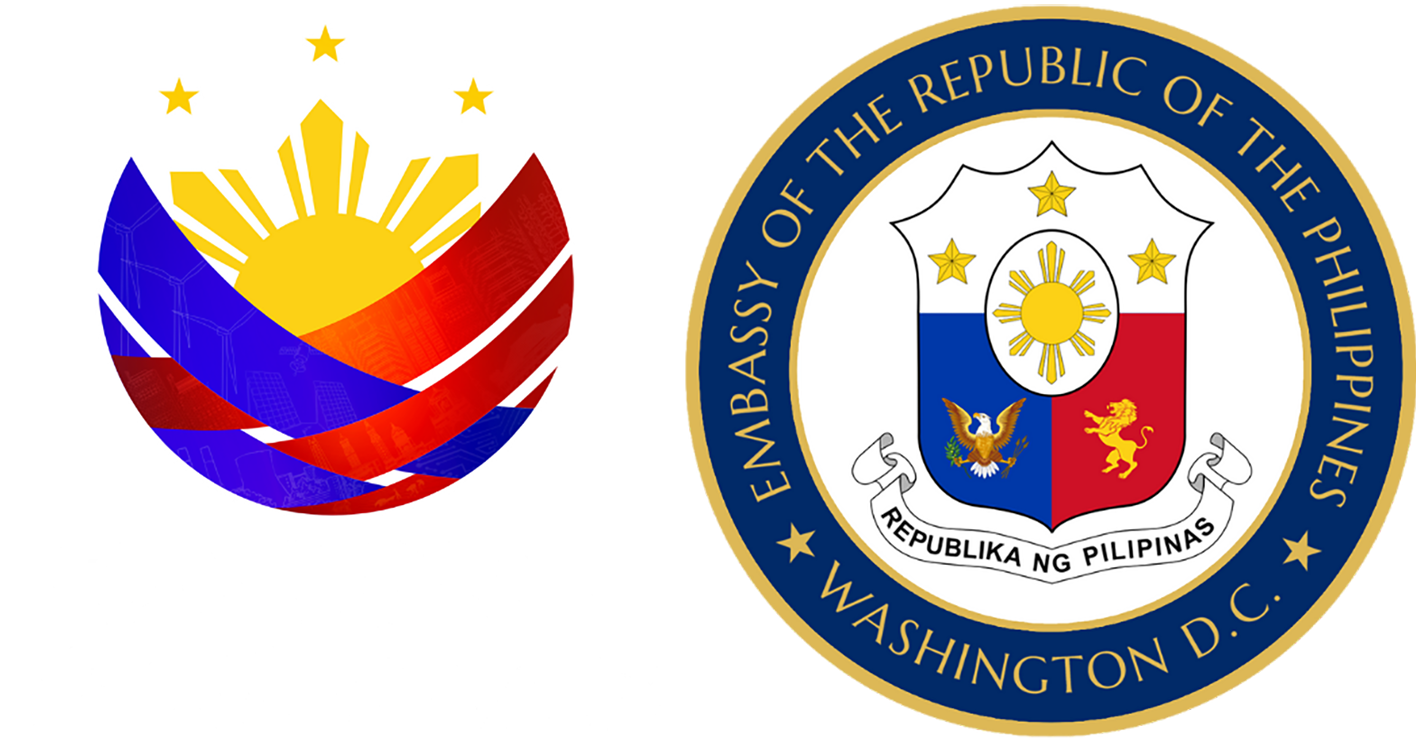Embassy of the
Republic of the Philippines
The Embassy (located in Washington, DC) is the principal representative of the Philippine Government in the conduct of its relations with the Government of the United States of America. In this capacity, the Embassy promotes the foreign policy thrusts of the Philippines, to wit:
- Promotion of closer and mutually beneficial bilateral ties between the Philippines and the United States;
- Promotion of national security;
- Promotion of economic diplomacy to support national development;
- Promotion of rights and welfare Filipinos overseas;
- Promotion of Philippine culture; and
- Promotion of a positive national image
The roles and responsibilities of the Embassy cover the following:
- Managing relations with the US government at the federal level through the White House, the National Security Council (NSC), the Department of State and other federal agencies, and with the U.S. Congress;
- Managing linkages with state and local-level governments in Alabama, Florida, Georgia, Kentucky, Maryland, North Carolina, South Carolina, Tennessee, Virginia and West Virginia, and the District of Columbia;
- Representing the Philippine Government and its agencies responsible for policy vis-à-vis Washington-based international organizations such as the World Bank, the International Monetary Fund (IMF), the International Finance Corporation (IFC), among others;
- Representing the Philippines in international conferences, symposia and fora;
- Managing ties with US-based constituencies that are of use in advancing the national interest such as:
- the business community
- the media, both national and international
- the academic community
- the “think tanks” or policy institutions
- the non-governmental organizations
- the Filipino-American community
- Monitoring U.S. policies on various regions especially Southeast Asia, Northeast Asia, South Asia, the Middle East, and Latin America.
Previous Ambassadors, Resident Commissioners, and Special Envoys
Relations with the United States of America began in 1907 when the Philippines was under American colonial rule. At that time, the Office of the Resident Commissioner in Washington D.C. was established and was headed by a Philippine Resident Commissioner. The following officials served as Philippine Resident Commissioners:
- Pablo Ocampo (1907-1909)
- Benito Legarda (1907-1913)
- Manuel L. Quezon (1913-1917)
- Teodoro R. Yangco (1917-1920)
- Isauro Gabaldon (1920-1928)
- Pedro Guevara (1923-1936)
- Camilo Osias (1929-1935)
- Francisco Delgado (1935-1936)
- Quintin Paredes (1936-1938)
- Joaquin M. Elizalde (1939-1944)
- Carlos P. Romulo (1944-1946)
When official diplomatic relations were then established on 04 July 1946 following Philippine independence from the United States, the Office of the Resident Commissioner in Washington D.C. became the Embassy of the Republic of the Philippines. The following officials served as our Ambassadors in the United States
- Joaquin M. Elizalde (1946-1952)
- Carlos P. Romulo (1952-1953; 1955-1962)
- Emilio Abello (1962)
- Amelito Mutuc (1962-1964)
- Oscar Ledesma (1964-1966)
- Salvador P. Lopez (1968-1969)
- Ernesto V. Lagdameo (1969-1971)
- Eduardo Z. Romualdez (1971-1982)
- Benjamin T. Romualdez (1982-1986)
- Emmanuel N. Pelaez (1986-1992)
- Pablo R. Suarez (1992)
- Raul C. Rabe (1993-1999)
- Ernesto M. Maceda (1999-2001)
- Albert del Rosario (2001-2006)
- Willy C. Gaa (2006-2011)
- Jose L. Cuisia Jr. (2011-2016)
- Jose Manuel G. Romualdez (2017-present)
- General Carlos P. Romulo (Special Envoy of President Ramon Magsaysay, February 1954 to September 1955)
- Ambassador Benjamin T. Romualdez (Special Envoy of President Ferdinand Marcos, August 1966 to early 1968)
- Ambassador Jose Manuel G. Romualdez (Special Envoy of President Rodrigo Duterte, July to December 2016).
Thrusts
Assistance to Nationals (ATN)
• Service to the public (FilCom/dual citizens) in the form of legal advice; consular assistance to nationals in distress; and
• Efficient processing of legal documents, passports and visas.
Politico-Military and Security Relations
• Projection of the current Administration’s policies;
• Maintenance of close cooperation between the Philippines and the U.S. in bilateral, regional and global issues;
• Enhancement of bilateral security relations through increased Mutual Defense Treaty (MDT)-related activities and military-to-military interaction;
• Tapping of available US resources that will benefit the modernization of the Armed Forces of the Philippines;
• Cooperation in transnational concerns such as terrorism, narcotics, avian flu, among others;
• Supporting the U.S. in promoting democracy, open markets, and non-proliferation;
• Reporting on U.S. policies regarding global, regional, bilateral and national political and security positions and initiatives of major interest to the Philippines; and
• Coordinates with Filipino-Americans on their “empowerment” activities that will also benefit the Philippines and Filipinos.
Enhancement of Positive Image
• Information dissemination: networking with think tanks and the academe;
• Liaising with media and securing positive coverage for the Philippines; and
• Promoting awareness of Philippine culture through partnerships with schools, museums and FilCom organizations.
Economic Relations
• Trade, investment, tourism, and technology transfer promotion and facilitation;
• Monitoring of science & technology and environment developments and opportunities;
• Economic, commercial, and agricultural policy representations;
• Presentation of economic developments and opportunities in the Philippines; and
• Focus on priority US programs such as the Millennium Challenge Account (MCA) of the Millennium Challenge Corporation (MCC) and petitions under the US Trade Representative (USTR) Annual GSP Review.
Functional Sections of the Embassy and Attached Services
The above-mentioned thrusts and functions of the Post are divided among the following functional sections of the Embassy:
Political Section
Economic Section
Consular Section
Administrative Section
Public Diplomacy Section
The Embassy is ably supported ably supported by the following attached agencies:
OFFICE OF THE DEFENSE AND ARMED FORCES ATTACHÉ (DAFAO)
Helps promote bilateral defense and military relations; coordinates military-to-military programs including the International Military Education Training (IMET) program as well as training programs on anti-terrorism; reports on defense-related policies and developments in Washington, D.C.; interfaces on behalf of the Philippine defense establishment with the U.S. military establishment; and coordinates military visits and exchanges. Also in charge of Filipino veterans-related issues, especially the campaign for the implementation of the Veterans Equity Bill. Due recognition was recently given by the US Congress.
PHILIPPINE OVERSEAS LABOR OFFICE (POLO) WASHINGTON DC
Monitors US labor policies as they affect trade with the Philippines, labor relations between the two countries and the employment of Philippine nationals in the US; promotes employment of Philippine nationals in targeted sectors of the US labor market through briefings and presentations to employers; coordinates with the consular section in extending assistance to Filipinos overseas workers in the United States and other countries under the jurisdiction of the Embassy such as the Caribbean countries; promotes the welfare and interest of more than 40,000 overseas workers in the US through counseling, mediation of labor cases.
Office of the Agriculture Attaché
Coordinates and assists in the development of food assistance and agricultural and fishery cooperation bilateral programs between the governments of the United States and the Philippines; monitors US agricultural policies that impact on Philippine agriculture; assists in the promotion of increased access of agricultural exports to the US market and further investments from the US in Philippine agribusiness; represents the Philippines in various meetings and conferences on agriculture and fisheries held within the North American region.
Office of the Commercial Attaché / Philippine Trade and Investment Center (PTIC)
Promotes exports and investments in coordination with the Economic Section; facilitates trade projects and opportunities; develops markets for Philippine export products; monitors for and reports to the Department of Trade and Industry (DTI) on US trade and investment policies that can affect Philippine trade to the US.
The Philippine Embassy maintains three government-owned properties in Washington, D.C.: the Old Chancery, the Main Chancery, and the official residence of the Philippine Ambassador to the United States of America.
Through the leadership of Congress, and the support of the DFA-Properties Committee, the Philippine Embassy was able to secure funding for major renovation and repair works on the three properties.
The Chancery Annex (Old Chancery)
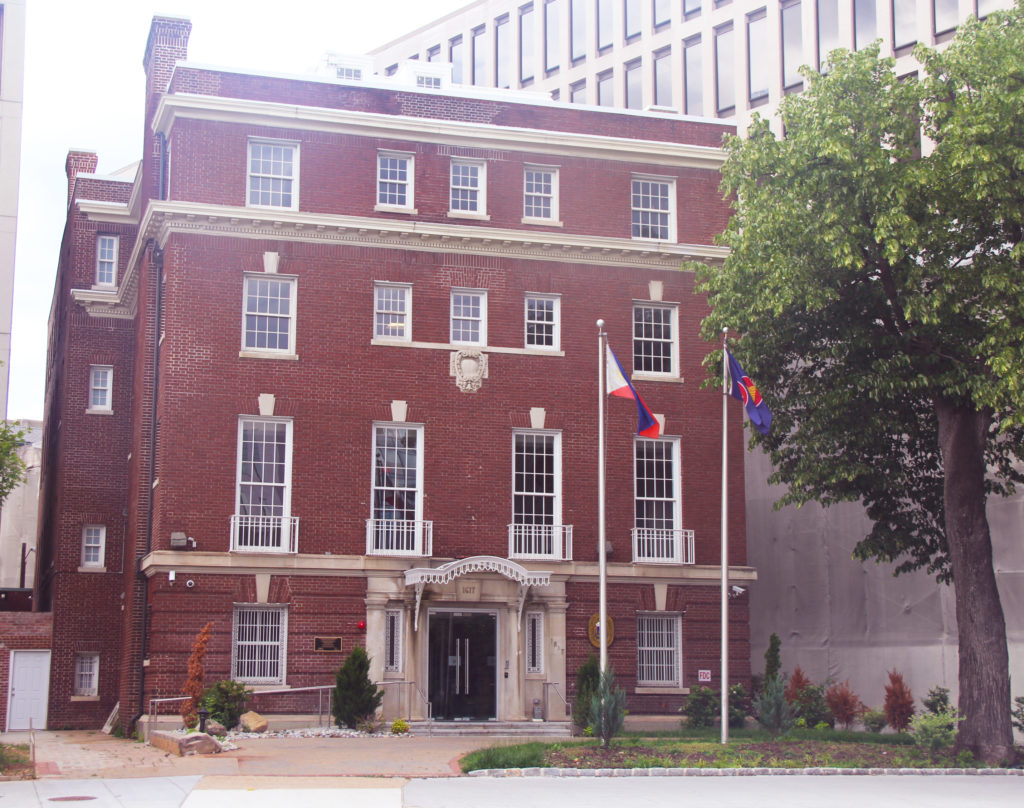
The Old Chancery, located at 1617 Massachusetts Avenue, N.W., was acquired on 13 October 1941 from Mrs. Stella Stapleton, wife of Daniel Stapleton, owner of two platinum mines in Ecuador and Colombia. It was at 1617 Massachusetts Avenue where the National Catholic Welfare Conference was first held and many welfare and religious projects were conceived and developed.
Although the Philippines acquired the property in 1941, the Office of the Resident Commission did not move in until 1943. For a time during World War II, the building was also the headquarters of the Philippine Commonwealth Government-in-Exile. When the Philippines achieved independence and became a Republic in 1946, the Office of the Resident Commissioner became the Embassy of the Philippines, and the building became the Chancery.
When the Main Chancery was inaugurated, the Old Chancery became the Chancery Annex. In 1998, the Government of the Philippines signed an agreement to turn over the Old Chancery to a coalition of Filipino American organizations to serve as a center for community activities. However, the deal did not come to fruition and the Old Chancery underwent several renovations since.
The Consular Section is located at the first floor and third floor of the building. The former office of the ambassador on the second floor was converted into an event space and renamed as the Quezon Hall, after former resident commissioner and president Manuel L. Quezon. The fourth floor houses the Embassy’s Sentro Rizal, the Philippine Overseas Labor Office—Overseas Workers Welfare Administration, and the Office of the Police Attaché.
Artworks of National Artist Fernando Amorsolo as well as contemporary Filipino artists can be seen in the building. The ground floor boasts an entryway lobby with hanging lamps from Kenneth Cobonpue (“Fandango”) and a wall mural by Mr. Dominic Rubio (“The Great Promenade of Philippine-American Friendship”) leading to the waiting area for consular applicants. On the second floor, Amorsolo’s Portrait of Manuel L. Quezon is the centerpiece of the Quezon Hall, and the multi-purpose room across is surrounded by several paintings from Filipino artists. The Ann Pamintuan’s metal furniture (“Cocoon”) are displayed at the Sentro Rizal on the fourth floor.
The building bears witness to several milestones throughout its history. In 1945, then-Resident Commissioner Carlos P. Romulo moved the Philippine flag to its peacetime position to officially mark “the coming of peace to the Philippines.” A year later, in July 1946, during the proclamation of Philippine independence, President Truman’s proclamation was read, the American flag was lowered, and the Philippine flag was raised.
In 1961, on the 19th Anniversary of the Fall of Bataan, the two small streets bordering Scott Circle were named Bataan and Corregidor Streets as a reminder of the close ties between the Philippines and the United States, as well as the shared experience “in defense of democracy and freedom.”
The Old Chancery also witnessed the danger that diplomats face in their line of work. On 18 November 1974, Philippine Ambassador to the United States Eduardo Z. Romualdez and economic attaché Mario S. Lagdameo were held at gunpoint for 10 hours in the Ambassador’s office. Diosdado M. Lorenzo’s portrait of Andres Bonifacio, which bears a hole from a stray bullet during the incident, is displayed on the second floor of the Chancery Annex to this day. In 1983, a week after the assassination of Senator Benigno S. Aquino, Jr., three men hurled two firebombs in front of the Old Chancery, shattering the main doors.
Due to its significance to our nation’s history, the National Historical Commission of the Philippines declared in 2018 the Old Chancery as a National Historical Landmark, the second structure to be designated as such outside of the Philippines.
The Chancery Annex underwent a second renovation starting in 2018 with the renovation of the two-level mechanical room at the back of the building. In 2019, power wash cleaning of the building’s exteriors and ground repairs and hardscaping were completed. The public area on the first floor was expanded to give more space for clients, and the second floor men’s room was converted into a pantry that will be used for events. The offices and conference room of the Consular Section are now found on the third floor. The fourth floor was renovated into offices of partner agencies that provide direct services to the public, and the Sentro Rizal. A steel perimeter fence was installed to improve the building’s security.
The Main Chancery
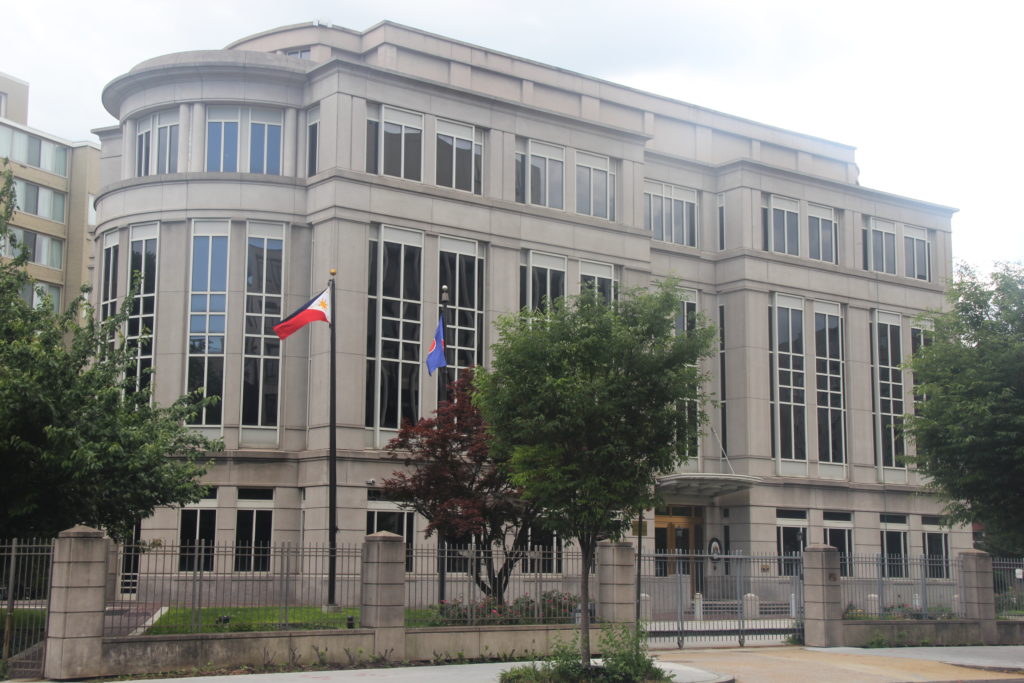
The Main Chancery is located at 1600 Massachusetts Avenue, corner Bataan St. N.W., Washington, D.C. 20036. It stands directly behind the standing figure of Daniel Webster, the “Expounder of the US Constitution” along Scott Circle. What is known as “Embassy Row” starts at Scott Circle, where chanceries and residences of Embassies accredited to the United States are located, and ends by the circular grounds of the US Naval Observatory on Massachusetts Avenue.
The classic lines of the Beaux-Arts building allow it to blend with the older, imposing buildings along Massachusetts Avenue. It stands alone on the block at the intersection of 17th Street and Massachusetts Avenue, facing the Johns Hopkins University Building, with the Embassy of Peru across the street at the right side and Beacon Hotel at the back, along N Street.
Plans for a new four-story and basement annex had come up as early as 1947, but it was only in 1969 that the land on 1600 Massachusetts Ave NW was acquired by the government. In November 1993, President Fidel V. Ramos inaugurated the building during his first Official Visit to Washington, D.C.
The reception area and the Defense and Armed Forces Affairs Office are located on the ground floor. A wood-paneled, marble-floored corridor leads to the Carlos P. Romulo Hall, where the Embassy hosts its events. The sweeping double staircase at the entrance leads to the offices of the Ambassador, the Deputy Chief of Mission, and the Administrative Section. The functional sections of the Embassy (Political and Legislative, Economic, and Public and Cultural Diplomacy), as well as the Embassy Library can be found on the third floor. The offices of Partner Agency Representatives (Agriculture, Foreign Liaison, and Commercial), conference rooms, and records room are all on the fourth floor.
For the first time since its inauguration, the Main Chancery underwent major repairs and renovation works in 2019. Various improvements were made to the exterior of the building, such as power wash cleaning, ground repairs and hardscaping. Inside, the carpets and flooring were replaced, the walls repainted, and LED lights installed. The Embassy also beefed up its security by upgrading its security cameras into high-definition CCTV and adding more security cameras.
Official Residence of the Ambassador
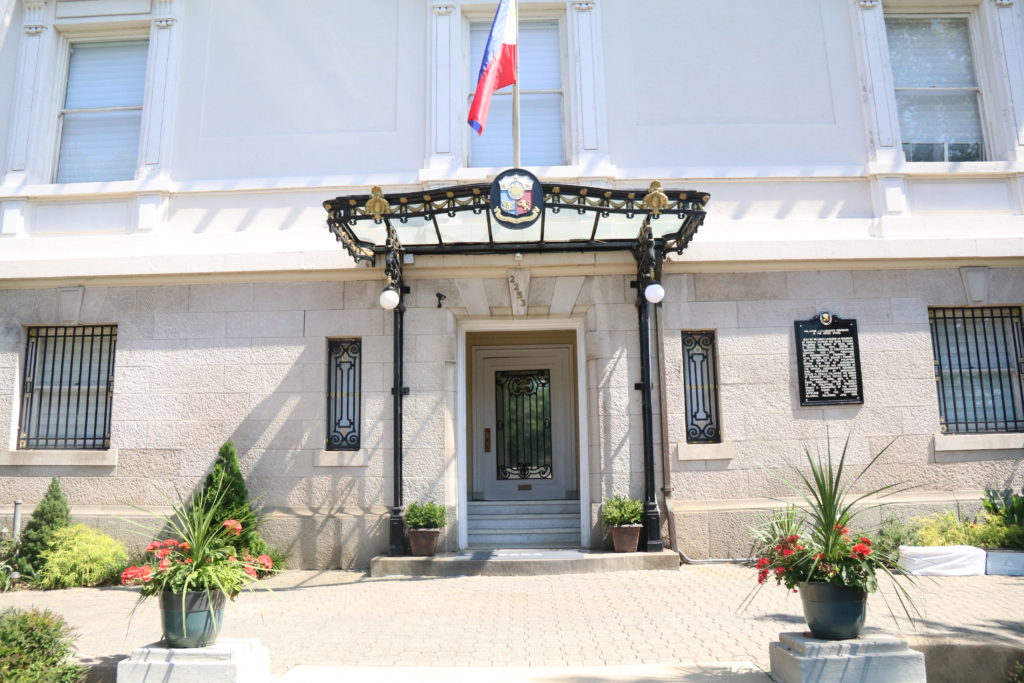
The official Residence of the Philippine Ambassador to the United States is located at 2253 R Street, N.W. Washington, D.C. Around the circle is a cluster of marble and sandstone mansions, once homes to the Washington elite. Now, many of these buildings sit on pieces of foreign soil and serve as chanceries of various embassies and residences of foreign ambassadors.
The three-storey sandstone mansion was built in 1904 for General and Mrs. Charles L. Fitzhugh. Then-Philippine Resident Commissioner to the U.S. Manuel L. Quezon had the opportunity to visit the house in 1913 as a guest of General Fitzhugh. He was impressed by the structure and design of the Residence, and openly expressed a wish to have a similar building for an Embassy when the Philippines obtained its independence.
In 1941, the Brittens bought the property from the widow of Gen. Fitzhugh. In 1946, the Elizaldes purchased the mansion from Mrs. Alma Britten, widow of Congressman Britten.
In 1949, the Philippine Government bought the property from the Elizaldes. Since then it has become the official residence of succeeding Philippine Ambassadors to the United States.
Under the initiative of Ambassador Carlos P. Romulo, the Residence underwent renovation in 1953. Filipino architect Victor Teotico re-designed the Residence and conceived a “Philippine Room”, that would house only Philippine items. It was in this room where Philippine President Carlos P. Garcia and US President Dwight D. Eisenhower signed a communiqué embodying Philippine-American friendship and mutual goodwill at the end of the former’s State Visit in June 1958.
The room is now called “Ambassador’s Filipiniana Room,” where the centerpiece is a 19 x 19 foot mural on one wall portraying life in the Philippines in all its color. The mural, called “Filipiniana”, was painted by Filipino painter Romeo Tabuena. Photographs of all Philippine Ambassadors to the U.S. who lived in the building are placed in this room.
At the foyer, one will see the glass sculpture donated in 2018 by world-renowned Filipino glass sculptor Ramon Orlina to the Philippine Ambassador. The first flight of stairs leads to a landing and an extended wing used as a tea room.
The second floor foyer is where the reception line is usually formed. A painting that shows sugarcane harvesting by R. San Miguel hangs on the left side of the room, while a lithograph of a woman being carried is on the opposite wall. A baby grand piano also occupies a section of the room. To the right of the receiving room is the dining room.
To the left of the receiving room are two adjoining rooms – the French Room and the English Drawing Room. The French Room has an Indian copy of the famous Aubuson rugs. The light color of the rug’s medallion design complements the French wall mural, thus making the room appear larger. The English Drawing Room has a fine Persian rug of rare colors and is decorated by various furniture and paintings by Filipino artists. Private quarters and guest rooms are located on the third floor of the Residence.
Major renovation works have been completed for the Ambassador’s three-story residence and its two-story carriage house. In 2018, emergency repairs and reinforcement works were done for the backyard retaining wall. In the same year, in an effort to stop the deteriorating condition of the carriage house that has not been used for a very long time, the Embassy installed a new roof and cleared the house of all the trash that had been kept on the first floor of the house.
In 2019, the wall of the carriage house was repaired and reinforced, as preparation for interior renovation works. In 2020, the entire renovation of the house was completed, including electrical, plumbing and installation of HVAC.
The Residence did not have a permanent and complete set of furniture and fixtures. Appointed ambassadors would usually bring their own personal properties. In 2021, the Embassy received funding from the Department’s Building Fund Program to fully furnish the Ambassador’s residence.
The Philippine Ambassador’s Residence is indeed a place of distinction. Rich in history and tradition, it is a witness to the Philippine way of life in an international setting. Like the Old Chancery, the Residence was designated as a National Historical Landmark by the National Historical Commission in the Philippines in 2021.
Sentro Rizal Washington DC
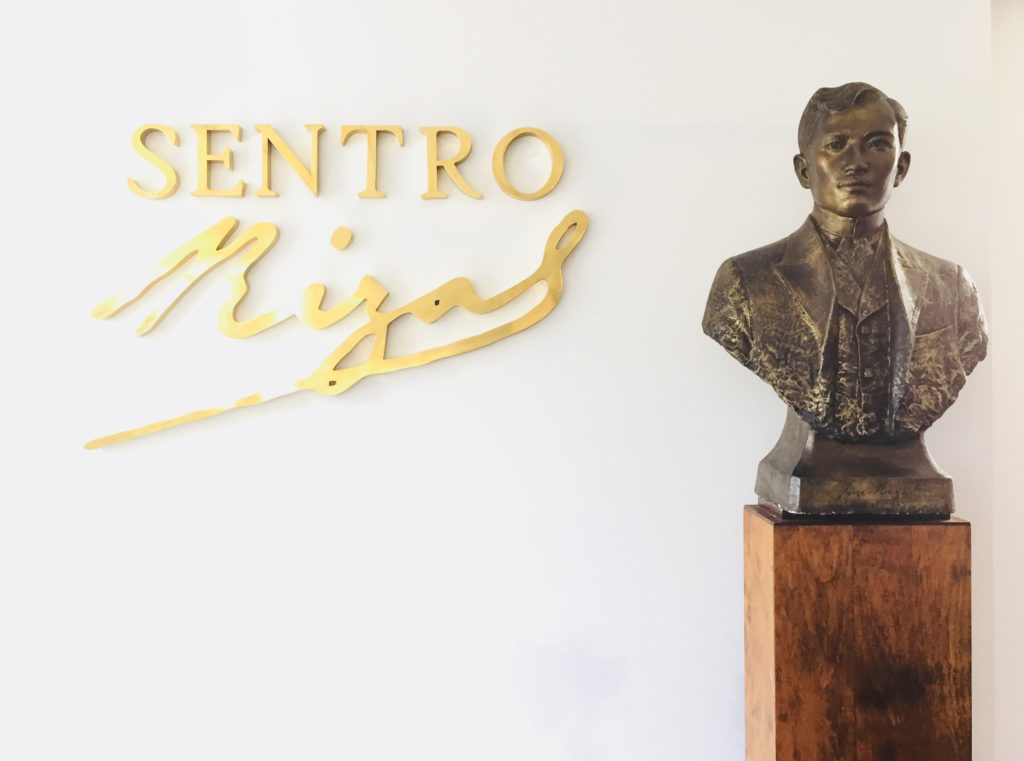
Sentro Rizal Washington DC is the 30th branch of the Sentro Rizal, which was recognized by virtue of Section 42 of the Philippine National Cultural Heritage Act of 2009, which specifies a center “whose main purpose is the promotion of Philippine arts, culture and language throughout the world.”
The Washington branch will serve as the primary vehicle through which the Embassy will conduct its cultural diplomacy programs.
Philippine National Commission for Culture and the Arts Chairman and National Artist Virgilio S. Almario graced the inauguration ceremony of Sentro Rizal Washington DC at the Philippine Embassy Chancery Annex on 10 June 2018.
You can read more about us by viewing the Sentro Rizal Primer.
